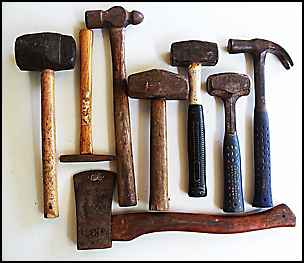 |
||||||
HammersA selection of hand hammers that are in my tool kit. Mostly the claw hammer is the main one that gets used but the others are all used from time to time.
For pulling out nails with a claw hammer sometimes it is better to put a block of wood under the claw to give you more leverage. It is also used many times to protect the main timber from damage marks made by the claw. If you have made a hammer mark in your nice timber, sometimes a bit of spit and a couple of light taps will swell it out again. Grip the hammer at the end of the shaft to get a nice swing from the wrist. If you hold it in the middle or near the head, you cramp your swing and bend nails all over. (Plus you are sure to be called a Boston Strangler sooner or later :-)< Not found it yet? Try this FAST SITE SEARCH or the whole web |
Hire Equipment  Furniture Fittings - Architectural Hardware - Electronic Locking Systems - Technical Hardware BuilderBill sponsorship Other Pages.
|
|||||
|
|
||||||
|
Please Note! The information on this site is offered as a guide only! When we are talking about areas where building regulations or safety regulations could exist,the information here could be wrong for your area. It could be out of date! Regulations breed faster than rabbits! You must check your own local conditions. Copyright © Bill Bradley 2007-2012. All rights reserved. |
||||||
